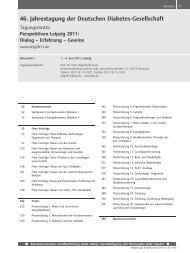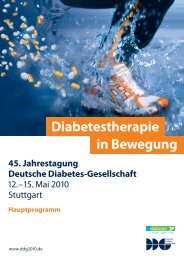Download Abstractbuch (Freie Vorträge und Poster)
Download Abstractbuch (Freie Vorträge und Poster)
Download Abstractbuch (Freie Vorträge und Poster)
Sie wollen auch ein ePaper? Erhöhen Sie die Reichweite Ihrer Titel.
YUMPU macht aus Druck-PDFs automatisch weboptimierte ePaper, die Google liebt.
zierte Freisetzung der Mediatoren. Nach Differenzierung in Gegenwart<br />
von 0, 1 oder 100 ng/ml LPS setzten mit 1 ng/ml LPS stimulierte Adipozyten<br />
absteigende MCP-1 Konzentrationen von 54,7 € 13,7 ng/ml,<br />
35,7 € 6,7 ng/ml <strong>und</strong> 18,8 € 3,9 ng/ml frei. Parallel sank die LPS-stimulierte<br />
IL-6 Freisetzung von 1,3 € 0,2 auf 0,6 € 0,1 ng/ml aus Zellen, die in<br />
Gegenwart von 1 oder 100 ng/ml LPS gereift waren. Um einen möglichen<br />
Effekt erhöhter Glc-Spiegel zu prüfen, wurden Präadipozyten in 1, 2 oder<br />
4,5 g/l Glc differenziert. Erhöhte Glc-Spiegel blieben ohne Einfluss auf<br />
die Freisetzung von MCP-1 (3,4 € 1,5 ng/ml) <strong>und</strong> IL-6 (0,1 € 0,1 ng/ml) aus<br />
reifen unstimulierten Adipozyten, führten jedoch zu einer signifikanten<br />
Steigerung der LPS-induzierbaren Freisetzung der Mediatoren. Nach<br />
LPS-Stimulation setzten ausgereifte Adipozyten 4,1 € 0,4 ng/ml (1 g/l<br />
Glc), 8,8 € 3,2 ng/ml (2 g/l Glc) <strong>und</strong> 11,8 € 4,1 ng/ml (4,5 g/l Glc) MCP-1<br />
frei. Parallel stieg die LPS-induzierte IL-6 Freisetzung von 0,2 € 0,1 ng/ml<br />
(1 g/l Glc) auf 0,7 € 0,1 ng/ml (2 g/l Glc) <strong>und</strong> 0,5 € 0,1 ng/ml (4,5 g/l Glc).<br />
Schlussfolgerung: Unsere Ergebnisse weisen darauf hin, dass sowohl<br />
immunologische als auch metabolische Faktoren, die während der Differenzierung<br />
auf (Prä-)Adipozyten einwirken, die TLR4-abhängige proinflammatorische<br />
Reaktionsbereitschaft ausgereifter Adipozyten nachhaltig<br />
beeinflussen.<br />
P283<br />
Histone deacetylase 6 – HDAC 6 – a new<br />
regulator of glucocorticoid receptor-mediated<br />
metabolic processes<br />
Winkler R 1 , Clemenz M 1 , Bloch M 1 , Foryst-Ludwig A 1 ,<br />
Böhm C 1 , Sprang C 1 , Matthias G 2 , Truee O 2 , Matthias P 2 ,<br />
Kintscher U 1<br />
1 CharitØ Universitätsmedizin Berlin, Center for<br />
Cardiovascular Research – Institute of Pharmacology, Berlin,<br />
Germany, 2 Friedrich Miescher Institute for Biomedical<br />
Research (FMI), Novartis Research Fo<strong>und</strong>ation, Basel,<br />
Switzerland<br />
The glucocorticoid receptor (GR) is an important regulator of insulin<br />
sensitivity and glucose tolerance. Since the histone deacetylase 6<br />
(HDAC 6) deacetylates heat shock protein 90, a GR chaperone, we investigated<br />
the effect of HDAC 6 on GR function in a metabolic context in<br />
vivo and in vitro. Wildtype (wt) and hdac6-deficient (HDAC 6ko) mice<br />
were subjected to 3 week 1 mg/kg intraperitoneal (ip) dexamethasone<br />
(dex) treatment. In wt-mice dex injection resulted in a marked glucose<br />
intolerance (ipGTT: glucose 30 min: vehicle 210 € 9.9.mg/dl vs. dex:<br />
273 € 30.6 mg/dl, p < 0.01) In HDACko mice dex-induced glucose intolerance<br />
was prominently attenuated (ipGTT: glucose 30 min: vehicle<br />
219 € 14.9.mg/dl vs. dex: 228 € 19.3.mg/dl, p = n. s.). Furthermore, dexmediated<br />
hyperinsulinemia in wt mice did not occur in HDACko mice<br />
indicating the absence of GR-mediated insulin resistance in these mice.<br />
To identify HDAC6-dex-dependent molecular targets, expression of major<br />
hepatic gluconeogenic genes such as phosphoenol pyruvatecarboxykinase<br />
(PEPCK), glucose-6-phosphatase (G6P), and fructose-1,6-bisphosphatase<br />
(F1,6BP) were evaluated by qPCR: All genes were significantly<br />
upregulated in livers of wt-mice after dex-treatment (PEPCK: 3.6-fold vs.<br />
vehicle; G6P: 1.6-fold vs. vehicle; F1,6BP 1.5-fold vs. vehicle, all p < 0.05).<br />
In contrast, dex-induced G6P and F1,6BP upregulation was absent in<br />
HDAC 6ko mice whereas PEPCK stimulation by dex was maintained.<br />
The divergent results for dex-mediated PEPCK- and G6P-regulation by<br />
HDAC 6 were supported in vitro by mRNA analysis in H4IIE rat hepatoma<br />
cells using siRNA techniques. The present study identifies HDAC 6 as an<br />
important regulator of metabolic GR-function preventing ligand-dependent<br />
induction of major gluconeogenic genes. Modulation of GR-function<br />
by HDAC 6 appears to be gene-specific which may provide an opportunity<br />
for therapeutic intervention.<br />
45. Jahrestagung der Deutschen Diabetes-Gesellschaft | 12.–15. Mai 2010, Stuttgart<br />
P284<br />
Glitazone-mediated vascular protection requires<br />
high mobility group A1 protein – a new<br />
PPARgamma coregulator<br />
Bloch M 1 , Prock A 2 , Paonessa F 3 , Foryst-Ludwig A 1 ,<br />
Kappert K 1 , Spranger J 4 , Unger T 1 , Fusco A 5 , Sedding D 2 ,<br />
Brunetti A 3 , Kintscher U 1<br />
1 Center for Cardiovascular Research (CCR) Institut für<br />
Pharmakologie, CharitØ – Universitätsmedizin Berlin<br />
Campus Mitte, Berlin, Germany, 2 Med. Klinik I/Kardiologie<br />
Universitätsklinikum Gießen, Gießen, Germany,<br />
3 Department of Clinical and Experimental Medicine „G.<br />
Salvatore“, University of Catanzaro, Catanzaro, Italy,<br />
4 Abteilung für Endokrinologie, Diabetes and<br />
Ernährungsmedizin, CharitØ-Universitätsmedizin Berlin,<br />
Berlin, Germany, 5 Instituto di Endocrinologia ed Oncologia<br />
Sperimentale del CNR, Neapel, Italy<br />
Previously we have shown that the chromatin-modifying high mobility<br />
group A1 protein (HMGA1) is required for Peroxisome Proliferator-activated<br />
Receptor gamma (PPARgamma)-mediated transrepression in vascular<br />
smooth muscle cells (VSMCs). The aim of the present study was to<br />
characterize the in-vivo relevance of HMGA1 in PPARgamma-mediated<br />
beneficial effects after vascular injury. The effect of pioglitazone (pio)<br />
treatment in wildtype (wt) and HMGA1-deficient mice on neointima<br />
formation was investigated in a mouse femoral artery after wire-induced<br />
injury. Arterial injury resulted in a prominent formation of a<br />
neointima in wt and HMGA1-deficient mice (neointima/media (I/M)<br />
ratio vs. uninjured contra-lateral artery 1.59 € 0.13 (wt-mice) and<br />
1.69 € 0.13 (HMGA1-deficient mice)). In wt mice, 3 weeks peri-/post-injury<br />
treatment with pio (10 mg/kg/d) led to significant 50% reduction of<br />
neointima formation (p < 0.01). In contrast, the protective actions of pio<br />
were completely abolished in HMGA1-deficient mice. In the mouse vascular<br />
injury model, the matrix-degrading matrix metalloproteinase-9<br />
(MMP-9) mediates new forming neointima in injured vessels, and thereby<br />
substantially drives vascular pathology. It has been reported that<br />
inhibition of MMP-9 is potently blocked by glitazone-activated PPARgamma.<br />
Thus, we examine the regulation of MMP-9 gene expression in<br />
the femoral artery of wt and HMGA1-deficient mice after vascular injury<br />
in the presence of pio-mediated PPARgamma activation. In wt mice<br />
injury-mediated vascular MMP-9 upregulation was reduced in the presence<br />
of pio-mediated PPARgamma activation (100%€ 38.87 vs.<br />
36.10%€ 18.39, p < 0.05). According to the lack of PPARgamma-mediated<br />
repression of MMP-9 in-vitro in the absence of HMGA1, the reduction of<br />
vascular MMP-9 expression by pio was completely abolished in HMGA1deficient<br />
mice (100%€ 38.87 vs. 114.51%€ 35.20, p = n. s.). To summarize<br />
these data confirm the importance of the PPARgamma-HMGA1 pathway<br />
for the vascular protective actions of PPARgamma-activating glitazones<br />
involving vascular MMP-9 regulation. The results identify HMGA1 as a<br />
substantial new regulator for PPARgamma-mediated inhibition of<br />
neointima formation. These data supply new information on the PPARgamma-dependent<br />
vascular transcriptional network, and support the<br />
<strong>und</strong>erstanding of molecular consequences of glitazone-therapy in the<br />
vasculature.<br />
P285<br />
TNFalpha and LPS – mediated inflammatory<br />
response in adipocytes and macrophages is<br />
attenuated by direct activation of angiotensin<br />
type 2 – receptors<br />
Wardat S 1 , Kintscher U 1 , Unger T 1 , Steckelings UM 1 , Foryst-<br />
Ludwig A 1<br />
1 CharitØ Universitätsmedizin Berlin, Institut für<br />
Pharmakologie – Center for Cardiovascular Research CCR,<br />
Berlin, Germany<br />
Angiotensin II exerts its effects through two different receptor subtypes:<br />
the AT1-receptor (AT1R) and the AT2-receptor (AT2R). The functional<br />
role of the AT1R in the development of insulin resistance (IR) is well<br />
<strong>und</strong>erstood, whereby AT1R blockers (ARBs) improve glucose intolerance<br />
and insulin resistance. In contrast, the role of the AT2 receptor in the<br />
regulation of glucose and lipid metabolism is still not clear. To determine<br />
the functional significance of AT2R stimulation in the development<br />
of IR and adipose tissue inflammation, we used the first non-peptide<br />
selective AT2R agonist, Compo<strong>und</strong> 21 (C 21), in an in-vitro model of 3T3-<br />
L 1 adipocytes. Treatment with TNFalpha (10 ng/ml for 24 h) led to a<br />
significant increase in the mRNA expression of several inflammatory<br />
markers including IL-6 (35 € 5.1-fold vs. control; p < 0.01) in mature<br />
adipocytes. Parallel treatment with C 21 (1 mM) significantly reduced<br />
Diabetologie & Stoffwechsel 2010; 5: S1–S106 Georg Thieme Verlag KG Stuttgart · New York · ISSN 1861-9002<br />
S95






